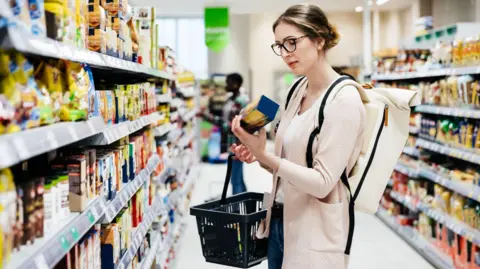As food prices continue to escalate, UK households are projected to see a significant increase in their annual groceries expenditure, amounting to an estimated £275 this year alone. This alarming trend has emerged as grocery prices have surged by 5.4% over the past month, propelling concerns among consumers regarding the affordability of their shopping. This data comes from the market research firm Worldpanel, which highlights a concerning shift in purchasing behaviors as individuals adapt to the rising costs.
The rise in grocery prices is particularly alarming, marking the most significant increase since the beginning of 2024. The average annual spending by UK households on food and drink currently stands at around £5,283; however, without modifications to buying habits, this expenditure is on a path to increase. To counter this, consumers appear to be shifting towards purchasing supermarket own-brand products, which are generally more affordable, in addition to simplifying their meals at home to cut costs.
Fraser McKevitt, the head of retail and consumer insight at Worldpanel, draws parallels between the current inflation of food prices and the spikes encountered in early 2022 following Russia’s full-scale invasion of Ukraine. Following that geopolitical crisis, the cost of energy and basic commodities soared, leading to continuous fluctuations in food prices over the years. Reflecting on these trends, McKevitt remarked, “We’re back up on that rollercoaster,” indicating a grim return to rising prices that consumers felt a year prior.
According to Worldpanel’s analysis, certain food categories have experienced the sharpest price increases recently. Specifically, items like chocolate, butter, spreads, and fresh meat saw considerable price hikes within the four-week period leading up to July 17. Interestingly, while some grocery segments are becoming pricier, there has been a contrasting decrease in the prices of dog food, sugar confectionery, and laundry products, providing consumers with some budgetary relief.
However, McKevitt suggests that most individuals have viable options to mitigate food costs. Strategies such as opting for more own-brand items, scouting for promotions, or shopping at discount retailers can help alleviate some of the financial pressure stemming from increasing food prices.
According to Worldpanel, approximately 20% of UK households find themselves struggling to keep up with grocery expenses, revealing a stark financial reality. Among this demographic, some families feel constrained in their ability to make further reductions in food costs. The ongoing analysis of shopping habits, which encompasses 30,000 households throughout the UK, indicates that many are resorting to simpler culinary preparations in a bid to save money. Alarmingly, the organization found that nearly seven in ten dinner plates consist of fewer than six components, reflecting a shift towards minimalistic meal preparations.
In summary, the current trajectory of food pricing in the UK presents mounting concerns for households already grappling with cost-of-living pressures. With escalating prices expected to raise annual grocery expenditures dramatically, consumers are adjusting their shopping habits in response. The situation is further complicated for a significant portion of the population who are, as noted by Worldpanel research, facing severe challenges in managing grocery expenses. This scenario anticipates ongoing shifts in both consumer behaviors and market dynamics as families across the nation continue to navigate the difficult landscape of rising food costs.










